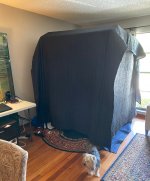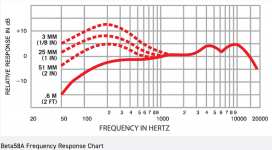After nearly three months of research, experimentation/troubleshooting, and a bunch of expenditure, I have arrived at a brick wall in my quest to get the equipment & environment situation correct for decent voice over recording. I am hoping the audio sages here can point me in the right direction before I spend any more time or money in waste.
In short, the problem I am encountering is a general mudiness in recordings and extensive presence of resonant frequencies regardless of microphone, input/recording device, or experiments with the design and location of my booth.
The booth I am troubleshooting is a 54” x 63” X 73” PVC cage lined with acoustic blankets and a carpet over hardwood floor. I also constructed five 4” rockwool panels which are temporarily laid against the corner walls in attempt to absorb nearby wall reflections. I’ve conducted a bunch of unsuccessful experiments over the past few weeks including placing the rockwool panels inside the booth, loading up the booth with pillows and extra sound-absorbent stuff, relocating the booth in my garage, taking out all furniture and equipment, microphone placement, etc…All to no avail!
Attached below are pics of the booth and recording environment.
I originally purchased a Rode NTG-3 shotgun mike in hope of using it for both voice over and video work. The recordings were terrible! By the time I realized an MKH-416 would have been worth an extra $300, B&H would no longer accept a return on the Rode. So I purchased two other mikes to try: Aventone CV-12 & Shure SM7b. The resonance in the CV-12 recordings (regardless of polar pattern) was full-spectrum, off-the-chart! I couldn’t even isolate problem frequencies with surgical EQ. Although the SM7b is much better (when set for flat or performance-boost), the recordings are still muddy with pronounced resonant frequencies scattered throughout the 100-1400 hz range.
While experimenting with Audition and iZotope RX 8, I discovered that reverb may be playing a role. Running a de-reverb filter seemed to make the recordings more workable and didn’t need as much aggression with notched EQ to reduce the resonant freqs. Nevertheless, no amount of surgical EQ, de-reverb, or de-noise seems to be successful in salvaging them. Or at least that I’ve been able to accomplish.
Following are links to unedited samples of the Rode NTG-3 and Shure SM7b recordings in the booth.
Any advice in remedying the recording situation or suggestions for successful post-production cleanup is VERY, VERY GREATLY appreciated!!!!
In short, the problem I am encountering is a general mudiness in recordings and extensive presence of resonant frequencies regardless of microphone, input/recording device, or experiments with the design and location of my booth.
The booth I am troubleshooting is a 54” x 63” X 73” PVC cage lined with acoustic blankets and a carpet over hardwood floor. I also constructed five 4” rockwool panels which are temporarily laid against the corner walls in attempt to absorb nearby wall reflections. I’ve conducted a bunch of unsuccessful experiments over the past few weeks including placing the rockwool panels inside the booth, loading up the booth with pillows and extra sound-absorbent stuff, relocating the booth in my garage, taking out all furniture and equipment, microphone placement, etc…All to no avail!
Attached below are pics of the booth and recording environment.
I originally purchased a Rode NTG-3 shotgun mike in hope of using it for both voice over and video work. The recordings were terrible! By the time I realized an MKH-416 would have been worth an extra $300, B&H would no longer accept a return on the Rode. So I purchased two other mikes to try: Aventone CV-12 & Shure SM7b. The resonance in the CV-12 recordings (regardless of polar pattern) was full-spectrum, off-the-chart! I couldn’t even isolate problem frequencies with surgical EQ. Although the SM7b is much better (when set for flat or performance-boost), the recordings are still muddy with pronounced resonant frequencies scattered throughout the 100-1400 hz range.
While experimenting with Audition and iZotope RX 8, I discovered that reverb may be playing a role. Running a de-reverb filter seemed to make the recordings more workable and didn’t need as much aggression with notched EQ to reduce the resonant freqs. Nevertheless, no amount of surgical EQ, de-reverb, or de-noise seems to be successful in salvaging them. Or at least that I’ve been able to accomplish.
Following are links to unedited samples of the Rode NTG-3 and Shure SM7b recordings in the booth.
- Rode NTG-3: https://cloud.cisadmin.com/index.php/s/XyPxn6nZdLiHMCE/download
- Shure SM7B: https://cloud.cisadmin.com/index.php/s/5gCXEjLJN9NnMol
Any advice in remedying the recording situation or suggestions for successful post-production cleanup is VERY, VERY GREATLY appreciated!!!!





